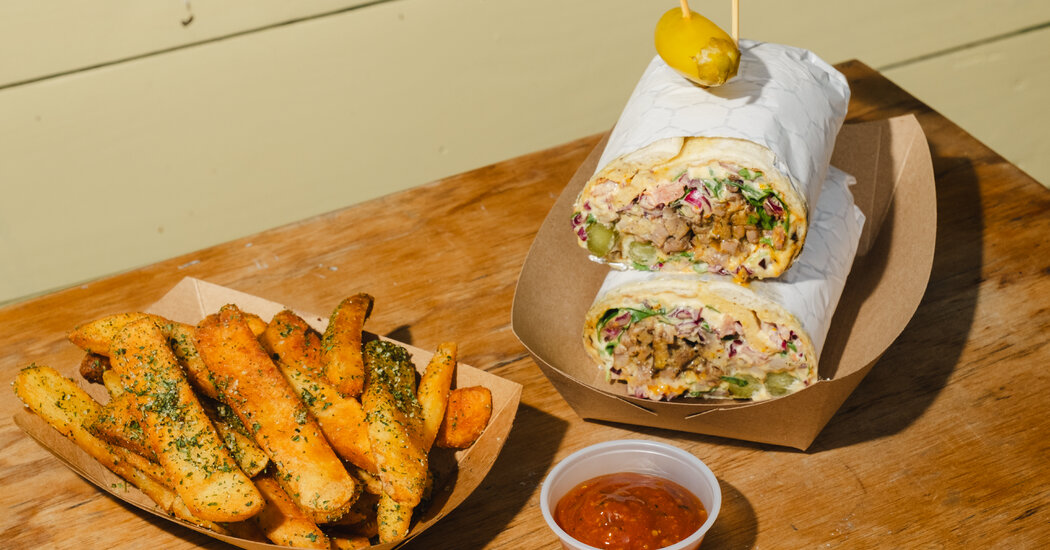For a long time, I thought of Lior Lev Sercarz as the chef who got away.
After moving to New York from France in 2002, he held prime spots in Daniel Boulud’s organization, first as a cook and sous-chef at Daniel for four years, followed by two years in charge of the catering kitchen. For many young cooks of that era, the Boulud finishing school was a ladder that led straight to a restaurant of their own. But instead of moving up and out the way Andrew Carmellini, Melissa Rodriguez, David Chang, Rich Torrisi, Hooni Kim and others did, Mr. Lev Sercarz stepped sideways. In 2010, he opened La Boîte, a closet-size shop on the western fringe of Hell’s Kitchen where he sold spice mixes and sophisticated little cookies, or “biscuits,” as he called them.
Mr. Lev Sercarz also made a line of off-the-rack spices that ordinary people could buy. Some of these did more for my enjoyment of life than just about any restaurant in town. The cardamom and star anise in the blend he calls Reims gave contours and shading to my poached apricots, and even made me enthusiastic about oatmeal. Lula, a green powder ground from seaweed, fennel, coriander seeds and who knows what else, made the simplest things — grilled porgy, buttermilk salad dressing, potato chips — at least three times more interesting. Microtonal composers and experimental jazz players are sometimes said to explore the notes between the notes. Mr. Lev Sercarz’s blends work in much the same way. The spices he buys, the way he grinds and measures and combines them, can make you taste the flavors between the flavors.
The more cabinet space I gave over to La Boîte’s squat little canisters, though, the more I wished Mr. Lev Sercarz would just start a restaurant already.
Finally, in September, he opened Spice Brothers with David Malbequi, a friend from the Boulud days. Wedged into a spot on St. Marks Place that has just enough room for five small tables, Spice Brothers is a shawarma stall. Shawarma may seem like an unlikely choice for two classically trained chefs, especially in a city that already has a full variety of revolving meat towers. But their insight is that shawarma can be a vehicle for rubs, marinades, sauces and last-minute dustings of one powder or another. Each sandwich and platter is a new chance to play with spices.
Spice Brothers serves two varieties of meat, called Shawarma East and Shawarma West. Shawarma East is sliced from an alternating stack of beef and lamb. The flavor is rich and sweet, like burning incense. Allspice shows up first, then cinnamon, and you can sense other things going on underneath. Shawarma West, made from chicken thighs, is more subtle, yellow with turmeric and smoky with pimentón. (Cumin, it should go without saying, features in both.)
Whether the meat is piled into a pita, rolled up in a sheet of laffa or spread on a platter, there will be a nest of shaved purple cabbage, arugula and chopped tomatoes. There will be swirls of very good tahina, thinned out by lemon juice and nutty with lightly toasted sesame. The same tahina flavors a creamy schmear of hummus. The piercing streaks of yellow sauce are amba, the mango-pickle condiment that the rest of the Middle East owes to the Jews of Iraq and that they owe to India.
The most compelling sauce at Spice Brothers is clearly the harissa, automatically spooned over chicken shawarma and sold on its own in a little plastic cup for a dollar. It is coarse-grained and a little crunchy like salsa macha, distinctly sour, and under its heat is a taste that’s reminiscent of smoked cherries. But there are no dull sauces here, not the dill-flecked labneh and certainly not the zhug which, with its fresh green herbs and jalapeño, is such a welcome and necessary contrast to the fried eggplant and hard-cooked egg that are stuffed into pita to make a sabich. Zhug and tahina are also squirted over the falafel pita; the falafel are satisfyingly crunchy, if not quite as juicy with fresh herbs as they could be.
Mr. Lev Sercarz spent most of his early years on a kibbutz in northern Israel and his adolescence near Tel Aviv. He has said that the aromas and flavors of shawarma as it’s eaten in Israel informed his ideas for Spice Brothers, although a typical Israeli shawarma shop would be more likely to serve turkey than chicken, would stock a wider variety of salads and pickles, and probably wouldn’t have labneh in the house. (Neither the restaurant itself nor the meat, supplied by Pat LaFrieda, is kosher.)
The shawarma stall of my dreams would bake the bread into which the shaved meat is packed. Spice Brothers buys its pita from a bakery in New Jersey and its laffa from one in Brooklyn. I don’t mind as much as I might, though, because for $4 more I can get shawarma served as a platter over a base of freshly cooked steak fries. They are dusted with a green powder that is essentially dehydrated zhug, and are thick and wide enough to drink up any excess sauce you pour on them — harissa, amba, tahina, even actual, undried zhug.
There is only one dessert, but it’s just right, a cup of rose-water-scented malabi made from coconut and almond milks in place of cow’s milk, with a spoonful of berry compote and flakes of toasted coconut on the side. If you have ever tasted a rose-water dessert that made you feel as if you were being suffocated by rose petals, you should know that this malabi is more a suggestion than an assault. It tastes of the flavors between the flavors.
Follow New York Times Cooking on Instagram, Facebook, YouTube, TikTok and Pinterest. Get regular updates from New York Times Cooking, with recipe suggestions, cooking tips and shopping advice.
